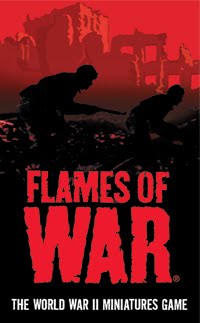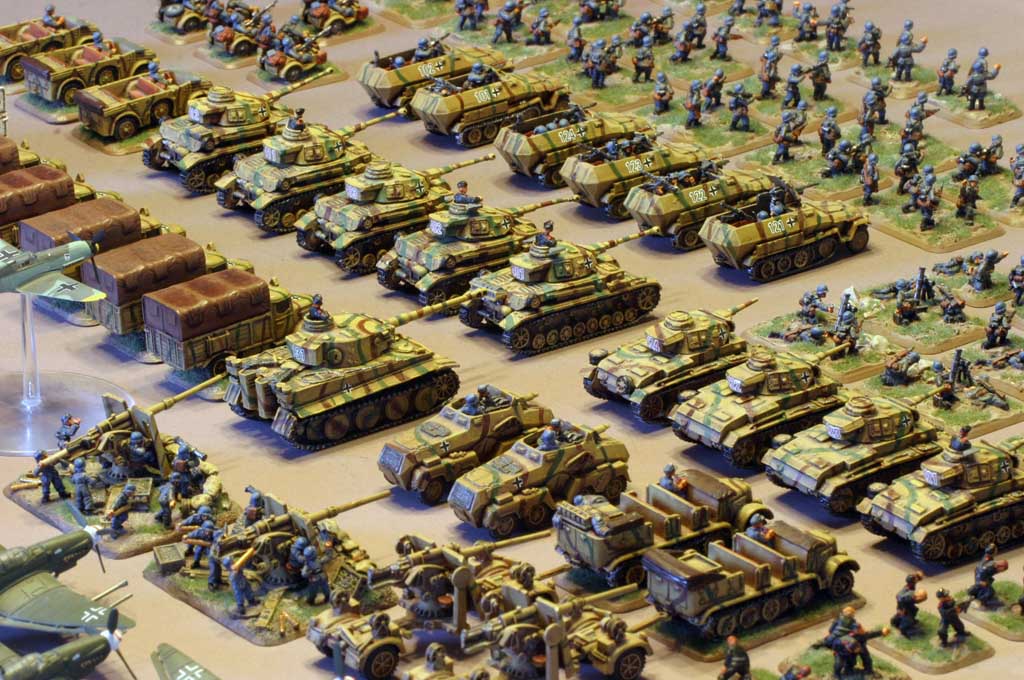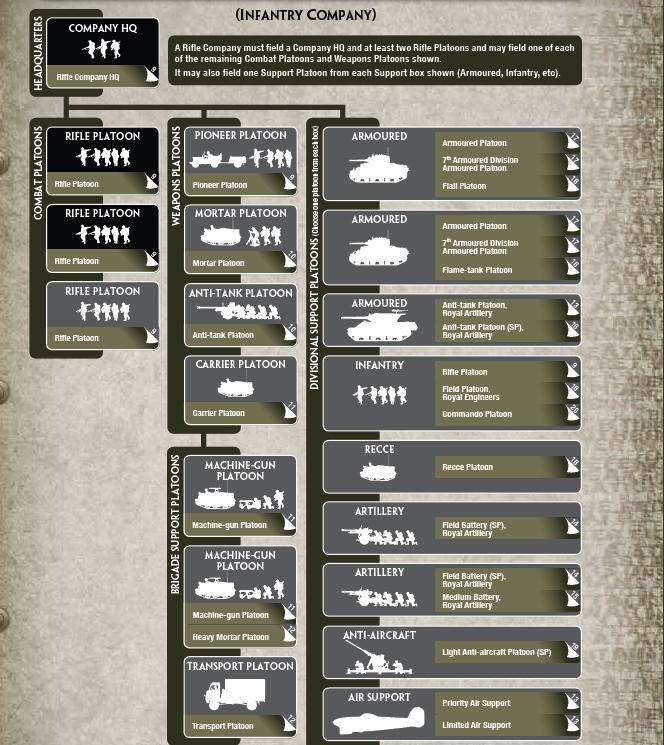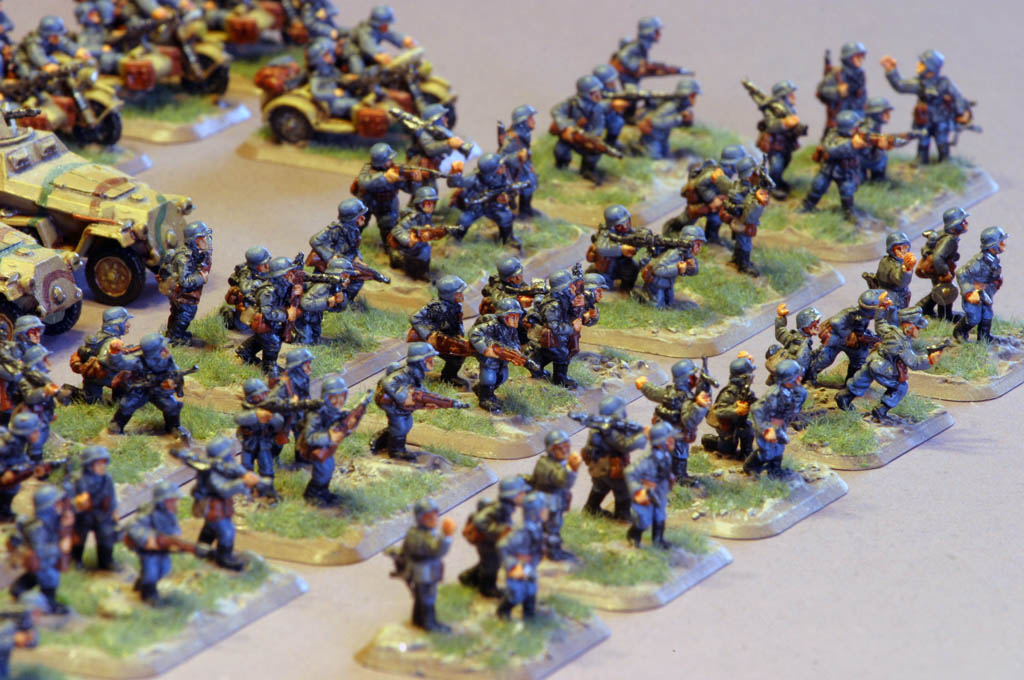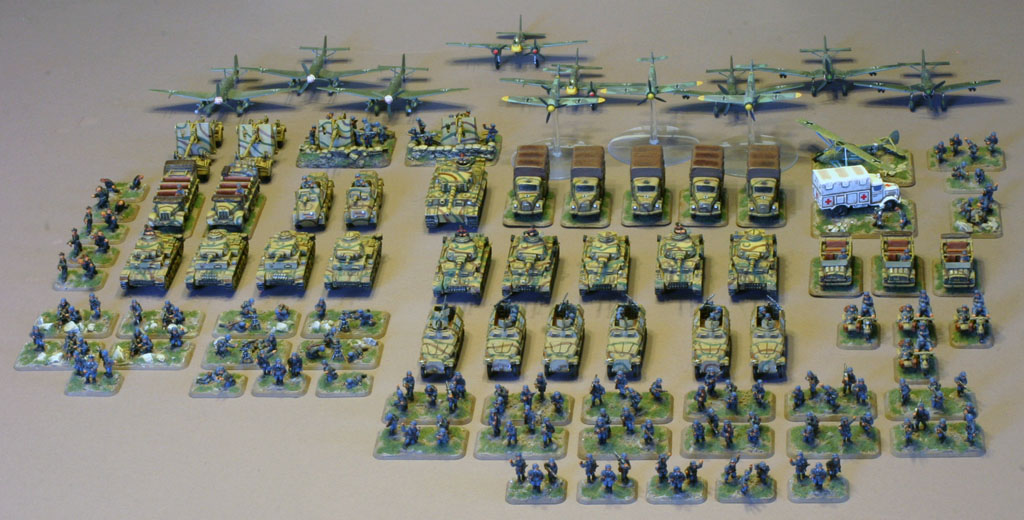Flames of War: Basic Training – Rules

Bulwark here agan. Now that we have had a brief introduction to Flames of War, it’s time to open up that box and dig in a little deeper into the basic rules.
Army Design
Flames of war is broken down into 3 main periods. Early-war (German blitz across Europe), Mid-war (North Africa and the eastern front) and Late-war (allied invasion of Europe) . Currently, FoW has lists for Midwar and Late-war. There are no lists for Early-war or the Pacific Theatre. When playing a game of FoW, it is important to choose a period you are playing in, as the technology and armor greatly increased between 1939 and 1945. It would be a shame to show up for a battle with your midwar Italian Tank company and have to face a latewar German Panther company (think ork buggies vs landraiders).
There are 4 main powers in Flames of War (mid-war includes Italy as a 5th). Each country has it’s own special rules. For example, German units get a free “stormtrooper” move in their assault phase while American artillery can have any platoon leader sight in for them. FoW is pretty good at limiting all the special rules to just these. There are very few unit specific special rules to learn. No need to go out and buy every new army book so you will know how to beat your opponent. Even when a new list is published, it is usually a change in the force organization, not new special rules.
Unlike other game systems, each army list for a country has (more or less) the same units to choose from, the only thing that changes is the quantities you can take. For example, a German Grenadier company can only take a single Heavy tank platoon, but a German Tiger company can take 4 of them (assuming you have the points for them). This allows each country to have many different list types, and each one will be unique. For example, a German Army based in the Ukraine may have more heavy tanks, while an army in eastern France may allow more artillery. All of the lists are very well balanced. So even if your British desert rats are facing a tank heavy German list, the game will still be a good one.
One of flames of War’s strength’s is the staggering number of units and army lists available. Want to play a German paratrooper list from the Battle of the bulge? They have a list for that. Want to play an American ranger list on D-Day? they have a list for that. Many nations have over 100 units to choose from.
There are 3 formal army list classifications: armor, mechanized and infantry. In missions where there is an attacker/defender, armor always attacks, infantry always defends and mechanized attack infantry, but defends against armor. So, in choosing your list type, you get some idea of the role you will play in many of the missions. Armor lists will tend to have more tank options, mechanized will utilize half tracks (or even trucks in midwar) and infantry will have, you guessed it, lots of infantry. After you buy the models for your particular company type, you don’t need to feel locked into that type. Going from an infantry to an Armored army is pretty easy; drop some infantry platoons and add a couple of tanks, and you are done.
Movement is pretty straight forward. Depending on the unit type (infantry, tank, half track, heavy gun team, etc) you have a certain movement value based on the type of terrain you are moving through. Infantry always moves 6″, regardless of terrain. Half tracks, however, move 12″ in the open, but only 4″ in heavily wooded areas. There is also the chance to vehicles and gun teams to get bogged down in some terrain types. There’s nothing quite so pleasing than to see a couple of panzers assault your infantry in the woods, only to get stuck and swarmed by the infantry.
Shooting in Flames of War uses a completly different concept than you are probably used to. The idea the guys at Battlefront went with is that any bozo can be taught to use a machine gun and spray a hundred bullets down field. It’s the skill of the target that determines if he gets hit. A veteran will know how to hide behind obstacles and move forward with military skill and precision without putting too much of his body in the open. A green conscript fresh off the farm however will have to rely more on luck than skill to avoid being shot. There are also modifiers for distance and being concealed. For example, an Italian heavy machine gun is shooting at a platoon of American infantryman that are in the woods. The Americans are rated as trained. This gives them a base 3+ to be hit. Because they are in cover they add +1 to be hit. This means that they are hit on a 4+. The heavy machine gun shoots 6 shots, and hits 3 times (on average). While there is no armor save in this game, there are saves. All infantry get a 3+ save (for being hard to hit) and gun teams/unarmored vehicles get a 5+ save. Going back to our Americans, 3 of them are hit, but 2 of them make their 3+ save, leaving only 1 casualty. This may not seem like much, but a full platoon of heavy machine guns could kill about half of that American platoon in 1 turn of shooting. And once you get a platoon below half, there are good odds that it will break and be removed from play.
Shooting at tanks is also a little different. Instead of taking the strength of the gun and adding d6 to see if it penetrates, you take the armor of the tank and add d6. The German Elephant (biggest tank in the game) has a front armor of 16. You would need a gun of strength 18 or higher to have a chance of penetrating that from the front. Just in case you were wondering, the highest strength gun the Americans have on their tanks is a 12. Much like WWII, the Americans have to be sneaky and get lucky side shots to take out the big German armor. Side shots also act a little different. In order to hit the side of a tank, you have to be behind a line drawn parallel to the front of the armor. This makes it difficult to do. But don’t worry to much, all tanks also have a top armor rating, and this never goes above a 2. Artillery, mortars, infantry assaults and aircraft always strike against the top armor.
Speaking of aircraft, don’t think your groundpounders and tanks have to go it alone. Fighter bombers are available and can be added to your army like any other support option. Each turn they have a percentage chance of coming in, and you can pay points to increase that chance. Once they arrive, they can strike anywhere on the table as long as they are not too close to your own forces. They are great for taking out hidden artillery batteries or that pesky Kingtiger.
Assault is also different. In a nut shell, you charge at an enemy 4″ away. The enemy platoon then conducts defensive fire (basically a free turn of shooting at you). If they score 5 hits, you are pinned own and the assault fails. If you get through the assault, you get into close combat. There are no infantry or gun saves in close combat, so it gets pretty bloody. In the assault, your opponent cannot fight back unless he makes a motivation test, if they pass, then can then attack you. Then it is your turn to pass a motivation test, you can then counter-attack them. This goes on until one side either dies, or runs away. The British are particularly good at close combat as they get to reroll their motivation to counter-assault. Stiff upper lips or some such… 🙂
Unlike some other games, as soon as a platoon is below 50%, they make a morale test. If they fail, they are removed from the game. As soon as your army has lost 50% of their platoons, your company commander makes a morale test, or your whole army runs away! One common tactic is to try to knock out the opponent’s company commander so they automatically fail their company morale test.

